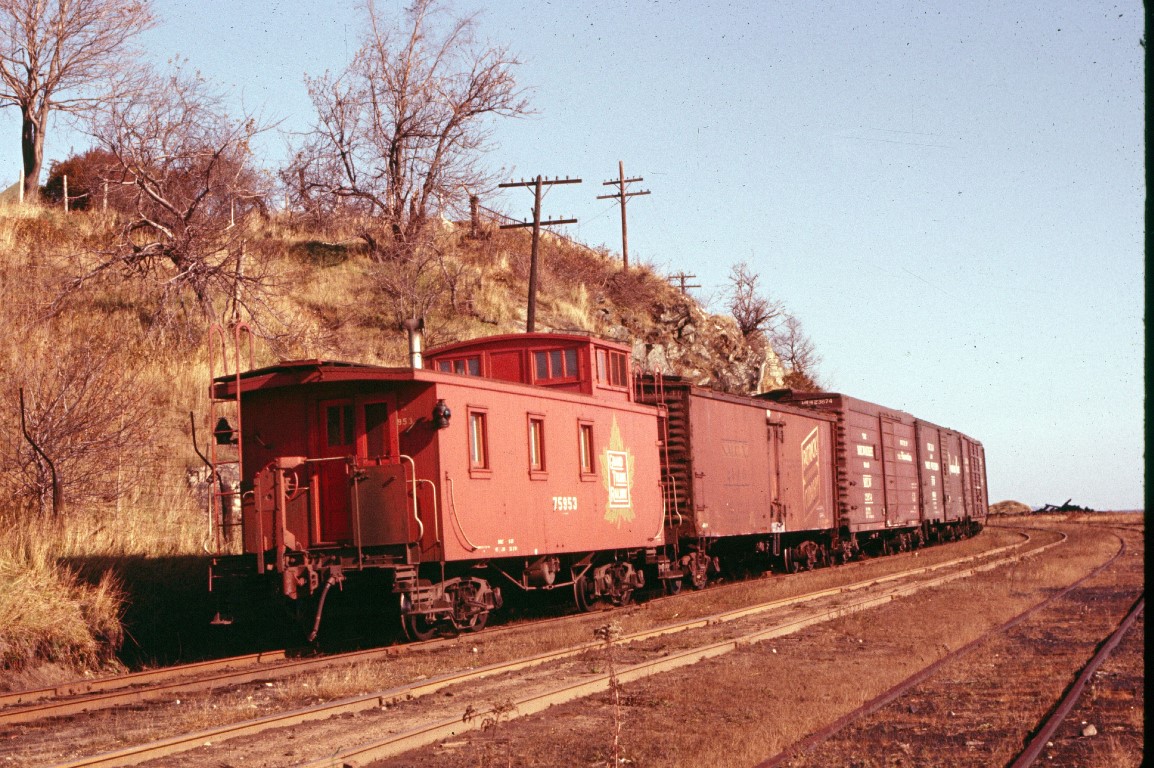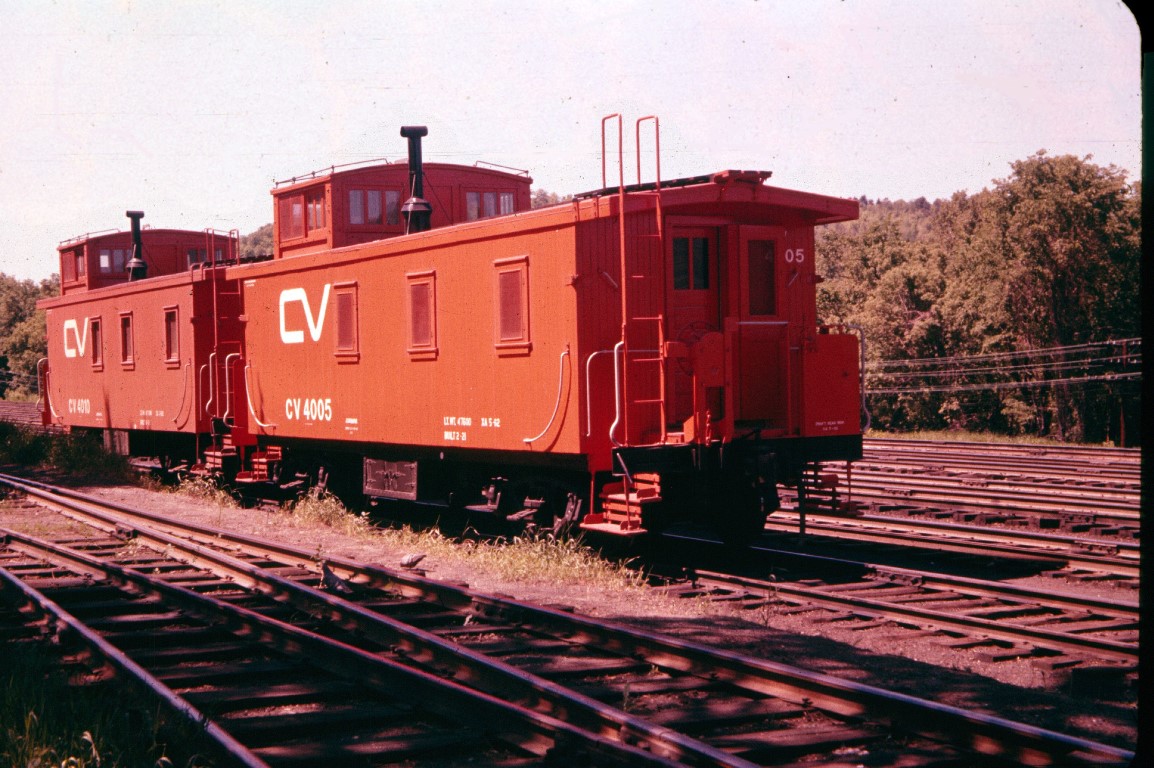
"Little Red Caboose"
Shelburne Falls Trolley Museum



This caboose was built in 1925 by the Central Vermont Railway. Cabooses were placed at the ends of freight trains, and served as homes-away-from-home and offices for conductors and brakemen - they had stoves and desks for the train crew, and beds for resting between trips. This caboose worked on the Central Vermont Railway between St. Albans, VT and New London, CT, passing through western Massachusetts regularly. It was sold to the Green Mountain Railroad before being retired in 1978 to be used as a poolside cabin in Amherst, MA. It came to the museum in 2000, where we restored it to its mid-1950's appearance. You may explore inside this caboose during regular hours.
Please make an Online Donation for the Caboose Fund to support the ongoing restoration and preservation of this beautiful piece of history.
Here are some pictures of moving 4015 from Amherst to the museum.

It came out of the blue. A phone call early in May 2000 from Jay Stryker, an Amherst Railway Society member (and new SFTM member), informing us of a caboose which had to find a new home within three weeks or face being scrapped in place. Were we interested?
The SFTM Board had been of the opinion that we would not collect any more rolling stock unless it was in mint condition, delivered at no cost, and came with a dowry. The caboose met none of these. Nevertheless, a delegation from SFTM went to the site, in Amherst MA, for a look.
The caboose, built by the Central Vermont Railway at St. Albans as No. 4015, and last operated by the Green Mountain Railway, had been acquired by Dr. Frederick Hess in the late '70's, and placed on a short section of track on his property. Now the property was to be sold by the end of May, and neither the new owner, nor anyone else to date, wanted the caboose. Our team noted that the car was definitely restorable, but would need a good deal of repair work. Unlike our trolley car, at least the caboose came with all its parts and hardware, from trucks to smokestack. While the caboose was living under a recently-built pole canopy when we found it, it had been stored out in the open for too many years, with the usual severe damage as a result. The site had been open and accessible when the caboose landed there, but a junior forest had grown up around it in the meantime. Multiple challenges, to say the least. Then there was the matter of SFTM's financial resources, best described as meager.
SFTM President Sam Bartlett took the bull by the horns, working out a donation of the car to SFTM, plus a part of the moving expense, by the owner. Then an estimate was obtained from a local rigger. Amherst Railway Society, which had already made a generous donation to SFTM earlier in the spring, offered to make yet another to help with the move. The Board agreed to go ahead with the acquisition with the understanding that no current Museum moneys were to be used to make up the balance of the moving cost, which amounted to around $2000. Luckily an individual donor came a across with the needed sum.
All of that was the easy part. Now trees had to be cut and a gravel roadway needed to be built from the street to the car. Some brake gear had to be cut off so the trucks could be removed. Finally there was room for a large crane to wiggle up to the caboose, and for a big flatbed for the caboose's ride to Shelburne Falls. The clock was ticking - it was getting close to the closing date on the property. But finally everything was loaded up and ready to go. And that was a hair-pull too, since there were miles of narrow country road, with lots of utility lines crossing it before the open highway was reached. Snails have been known to move faster.
On May 31 2000, after nearly a week en route on account of the rigger trying to squeeze this job into his other scheduled work, the truck and the crane arrived at SFTM. First, the trucks were set, properly spaced, on a yard track, then the crane swung the caboose through the air (without taking out any trolley wire on the way), and set the body on its trucks. The rest of the story was now up to SFTM.
Here are some more pictures, first some vintage photos of cabooses of the same class from the
"Ambassador", the newsletter of the Central Vermont Railway Historical Society.









The Shelburne Falls Trolley Museum exists due to the generosity of members, visitors and friends. Tickets cover about one-third of our operating costs. Donations are tax-deductible, the museum is a 501(c)(3) organization, run entirely by volunteers. Our Tax ID is 04-3133373. Feel free to research our operation at Guidestar.org.
To make a financial donation, please send a check made out to "SFTM",
to:
Shelburne Falls Trolley Museum
PO BOX 272
14 Depot Street
Shelburne Falls, MA 01370
If you wish you may designate your donation for a specific SFTM project in the memo line of your check:
General Fund,
Car Barn Extension,
"Berkshire Hills" Parlor Trolley,
MBTA PCC Cars,
B&M Box Car,
MBTA Line Car 3283,
CV Caboose 4015
or Volunteer Appreciation.
The General Fund is available for us to use to cover our costs of operation (insurance, electricity, etc.) or, if we have enough, we can transfer it to one of the other project funds.
After you click the "Donate" button below you may designate your donation for a specific SFTM project:
General Fund,
Car Barn Extension,
"Berkshire Hills" Parlor Trolley,
MBTA PCC Cars,
B&M Box Car,
MBTA Line Car 3283,
CV Caboose 4015
or Volunteer Appreciation.
The General Fund is available for us to use to cover our costs of operation (insurance, electricity, etc.) or, if we have enough, we can transfer it to one of the other project funds.
14 Depot Street Shelburne Falls MA 01370 413-625-9443 trolley@sftm.org